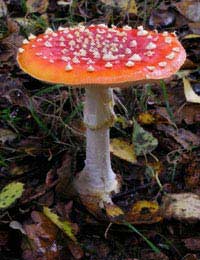Identifying Poisonous And Dangerous Foods

In a survival situation when you’re looking for food, your choices will consist of one or more of a combination of things that grow, walk, crawl, swim or fly and whilst many a plant or creature will provide you with nourishment to help you to stay alive, many are highly dangerous and/or poisonous and some can kill you more quickly than if you hadn’t eaten at all. So, what are some of the more common foods we should avoid at all costs in a survival situation?
Plants, Berries and Fungi
Plants, berries and fungi are probably the most difficult category to determine when it comes to considering whether or not they are safe to eat and it cannot be emphasised enough that you should not eat anything that grows out of the ground or on trees unless you are absolutely 100% sure that it’s safe to eat.Certain plants can poison on contact through skin absorption, by ingestion or inhalation through the respiratory system. These include hemlock, castor bean and castor oil plant, oleander, lantana, poison ivy, poison oak, death lily and many varieties of fungi which can be lethal. This list barely scratches the surface however. The only way to be sure is to do the research and find out what plants are growing in the particular location you’re heading to and learn how to identify those which are safe to eat. Taking a guidebook with pictures is a good idea for survival.
Insects as a Meal
Whilst insects may not be the first choice on your menu, they are usually the easiest kinds of ‘meal’ to find and provide you with a very rich source of protein for survival. Ants, termites, grubs and worms are fine but, as a general guideline, you should avoid eating all insects which sting or bite, are very hairy or are brightly coloured, caterpillars and any insects which give off a pungent odour. Also avoid eating potentially disease carrying insects such as flies, mosquitoes and ticks.With insects that have a hard outer shell such as a beetle, for example, these will contain parasites but are safe to eat as long as you cook them first. You can eat most insects raw if preferred but always remove wings and any barbed legs first.
Eating Fish
There are no poisonous freshwater fish so you can eat them safely but you should cook them to get rid of any parasites first. Some saltwater fish further out to sea will not contain any parasites so these can be eaten raw. However, certain species have poisonous skin which includes the porcupine fish, red snapper, jack and puffer so these should never be eaten raw. There are also several species of tropical fish which are highly poisonous and you should do your research first if you are venturing into areas which contain these types of fish.Making a Dinner of Amphibians
Most species of frog are safe to eat but you should avoid eating any brightly coloured ones or those which have a distinctive X mark on their back. However, frogs should not be confused with toads which secrete a poison if they’re in fear of an attack. Toads tend to inhabit drier areas than frogs and you should not even handle, let alone eat, a toad.Eating Birds to Survive
All bird species are edible although the taste varies tremendously.Mammals as Food
All species of mammals are edible but both the polar bear and bearded seal have dangerous toxic levels of Vitamin A in their livers. In Australia, the platypus has poisonous glands and scavenging mammals can often carry diseases.If you are serious about survival techniques, it can pay off greatly to learn all about the kind of vegetation and wildlife that is prevalent in the area you’re travelling to in order that you can easily distinguish what’s safe and not safe to eat. It can even save your life.


Re: How to Get Out Of A Mud Bog (Quicksand)
I was 8 years old, my family went to visit our neighbors where we previously lived in Tool,Texas. The family had…
Re: How to Get Out Of A Mud Bog (Quicksand)
I was sinking in a mud bog yesterday for 3 hours until I was pulled out. How do I cope now?
Re: Dangers and Benefits of Leeches
Can it penetrate completely into the body through navel ? If, then how one can know that it has entered into body ? And what…
Re: How To Survive A Forest Fire
I like cheese.... ????????????????????????????
Re: Dangers and Benefits of Leeches
The easiest way to remove a leech from skin is just by sprinkling salt over the leech which would immediately detaches itself…
Re: Dangers and Benefits of Leeches
I'm 14 and was swimming st Brady's run in beaver county and I got bit by a leech.. I would of never knew unles my boyfriend…
Re: What Are Survival Seeds?
The other evening, I found all my matches were damp and I had to ignite my wood burning stove using a rolled up piece of paper and my…
Re: Where Can I Try Out my Survival Skills?
i been doing some survival practise is my back garden but i could use some new bet cheap and relieable gear. thank you
Re: Surviving in the Desert
Hi I am in the process of doing research for a novel. The main characters are trapped in a desert and there is an on coming sandstorm.…
Re: How to Start a Fire
So lets just say, I am aware this sounds crazy but hear me out, what if there was a zombie apoccolypse (Have no frickin idea how to spell…